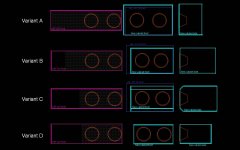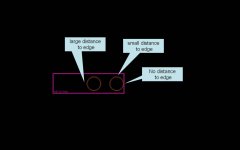Honored community, I just registered to this outmost exciting forum which I was lurking for a while already. A lot of valuable knowledge circulates here. Respect! 
I have a couple of projects ongoing but few experience. Among them a pair of speakers which I would like to submit to your appreciation:
Target
- to own a pair of decent near field studio monitors
- they must have a concentric driver for the HF/LMF range
- they must provide enough bass to live without subwoofer
- they must have bookshelf format
- they can be passive
- they should integrate some of the available gear listed below due to restricted budget
Available stuff
- a pair of KEF iQ7 speakers complete with all drivers and filters
- pair of KEF SP1575 coaxial drivers (complete w/ both LMF and HF sections), no filter, (origin = KEF iQ30, iQ70, iQ90)
My first approach would be to build a bookshelf enclosure for all the iQ7 components. A plain square box which has the same volume than the original KEF. Migrate all components from the iQ7 into the new house, end.
The KEF components have a very decent sound in their original cabinets. I would be totally satisfied if I achieved this quality. Now, I wonder how much a new housing would affect the sound. Is there a risk to ruin the sound? Or, in the contrary, is it the opportunity to even improve the systems? I am prepared to do quite a bit work on the cabinets with internal reinforcements, labyrinth, separated volume for the HF/MF section, what ever … if needed/recommended.
How about going even further: changing the 3 way into a 2.5 way system? The use as near field monitors instead of main hifi speakers might allow and benefit from it.
An additional thought is to use the SP1575 instead of the iQ7 driver.
They have a different look (tangerine waveguides) are the newer generation but I cant find much information about the actual differences.
Q SERIES iQ30
Q-Series Technology - KEF Q-Series Technology
Any comments and recommendation would be highly appreciated. Thanks!

I have a couple of projects ongoing but few experience. Among them a pair of speakers which I would like to submit to your appreciation:
Target
- to own a pair of decent near field studio monitors
- they must have a concentric driver for the HF/LMF range
- they must provide enough bass to live without subwoofer
- they must have bookshelf format
- they can be passive
- they should integrate some of the available gear listed below due to restricted budget
Available stuff
- a pair of KEF iQ7 speakers complete with all drivers and filters
- pair of KEF SP1575 coaxial drivers (complete w/ both LMF and HF sections), no filter, (origin = KEF iQ30, iQ70, iQ90)
My first approach would be to build a bookshelf enclosure for all the iQ7 components. A plain square box which has the same volume than the original KEF. Migrate all components from the iQ7 into the new house, end.
The KEF components have a very decent sound in their original cabinets. I would be totally satisfied if I achieved this quality. Now, I wonder how much a new housing would affect the sound. Is there a risk to ruin the sound? Or, in the contrary, is it the opportunity to even improve the systems? I am prepared to do quite a bit work on the cabinets with internal reinforcements, labyrinth, separated volume for the HF/MF section, what ever … if needed/recommended.
How about going even further: changing the 3 way into a 2.5 way system? The use as near field monitors instead of main hifi speakers might allow and benefit from it.
An additional thought is to use the SP1575 instead of the iQ7 driver.
They have a different look (tangerine waveguides) are the newer generation but I cant find much information about the actual differences.
Q SERIES iQ30
Q-Series Technology - KEF Q-Series Technology
Any comments and recommendation would be highly appreciated. Thanks!
Unless you have the facility to measure the driver parameters, the best you can do really is duplicate the original boxes. By all means add more bracing and suchlike, but try and keep both the original internal volume, (for optimal bass response), and the size of the front the same, (the crossover will likely have "baffle step compensation" to allow for the way the speaker radiates sound into space).
Good luck, and post plenty of pics of your experiments, we like pics here!
Good luck, and post plenty of pics of your experiments, we like pics here!
Hi,
some time ago a heard a pair of the new Q100's with a (I think Wavecor) 10" in closed Box as a pc-based nearfield solution. The KEFs stand about 35" apart.
The system is fully FIR-filtered!
Music is played through Foobar2000 with a plugin for the FIR-correction. The correction file was processed with Acourate: (((acourate)))® - Room Correction, Speaker Optimization and Sound Improvement.
This sounded realy nice
some time ago a heard a pair of the new Q100's with a (I think Wavecor) 10" in closed Box as a pc-based nearfield solution. The KEFs stand about 35" apart.
The system is fully FIR-filtered!
Music is played through Foobar2000 with a plugin for the FIR-correction. The correction file was processed with Acourate: (((acourate)))® - Room Correction, Speaker Optimization and Sound Improvement.
This sounded realy nice
Hi Pinkmouse and Breslaan,
Thanks for the interesting but challenging hints.
I believe a Q100 with FIR sound great. But I would go this way as second step. First I want to set up a standalone monitor with a sound as neutral as possible.
The biggest challenge will reside in achieving the same surface. Near field monitors are typically situated on the rack on top of a mixing desk. Therefore a small size is preferable. If I maintain the same surface I'll end up with big size monitors less suitable for nearfield use. Please have a look on my drafts enclosed. They aim to understand the situation and to settle basic layout directions (they have approximate dimensions).
KEF iQ7 front : purple
New enclosure front and side : cyan
JBL4311B : blue (for reference)
The dotted zone on the KEF shows a surface equal to the front of the new cabinet.
Variant A: same surface/same volume. Result is a huge box, difficult to place on top of a mixing console. For reference I show the size of the well known JBL4311 (L100, 4312) which is already quite massive.
Variant B: smaller surface/same volume. I limited arbitrarily the dimensions to allow an easy use on top of a mixing console.
Variant C: here I did not observe the surface at all but the distance from the drivers to the cabinet edge. The volume is maintained by introducing 45 degree edges.
Variant D: neat and handy, this utopic cabinet shows the ultimate, but certainly impossible target. Neither surface nor volume are maintained.
Your remarks and this preliminary analysis make me reconsider the project and rise a couple of questions:
In the second picture I point out different spots: in some spots the cabinet edges are really nearby the drivers. In other spots the cabinet limits are far from the drivers. Is there a sort of "relevant" zone or is the totality of the original surface relevant? Is it more important to respect the surface, or the distance to the edges and therefore the overall original shape?
I'd appreciate your comments. Many thanks!
Thanks for the interesting but challenging hints.
I believe a Q100 with FIR sound great. But I would go this way as second step. First I want to set up a standalone monitor with a sound as neutral as possible.
The biggest challenge will reside in achieving the same surface. Near field monitors are typically situated on the rack on top of a mixing desk. Therefore a small size is preferable. If I maintain the same surface I'll end up with big size monitors less suitable for nearfield use. Please have a look on my drafts enclosed. They aim to understand the situation and to settle basic layout directions (they have approximate dimensions).
KEF iQ7 front : purple
New enclosure front and side : cyan
JBL4311B : blue (for reference)
The dotted zone on the KEF shows a surface equal to the front of the new cabinet.
Variant A: same surface/same volume. Result is a huge box, difficult to place on top of a mixing console. For reference I show the size of the well known JBL4311 (L100, 4312) which is already quite massive.
Variant B: smaller surface/same volume. I limited arbitrarily the dimensions to allow an easy use on top of a mixing console.
Variant C: here I did not observe the surface at all but the distance from the drivers to the cabinet edge. The volume is maintained by introducing 45 degree edges.
Variant D: neat and handy, this utopic cabinet shows the ultimate, but certainly impossible target. Neither surface nor volume are maintained.
Your remarks and this preliminary analysis make me reconsider the project and rise a couple of questions:
In the second picture I point out different spots: in some spots the cabinet edges are really nearby the drivers. In other spots the cabinet limits are far from the drivers. Is there a sort of "relevant" zone or is the totality of the original surface relevant? Is it more important to respect the surface, or the distance to the edges and therefore the overall original shape?
I'd appreciate your comments. Many thanks!
Attachments
- Status
- This old topic is closed. If you want to reopen this topic, contact a moderator using the "Report Post" button.

